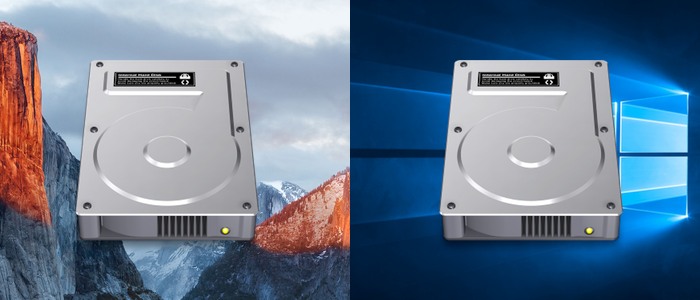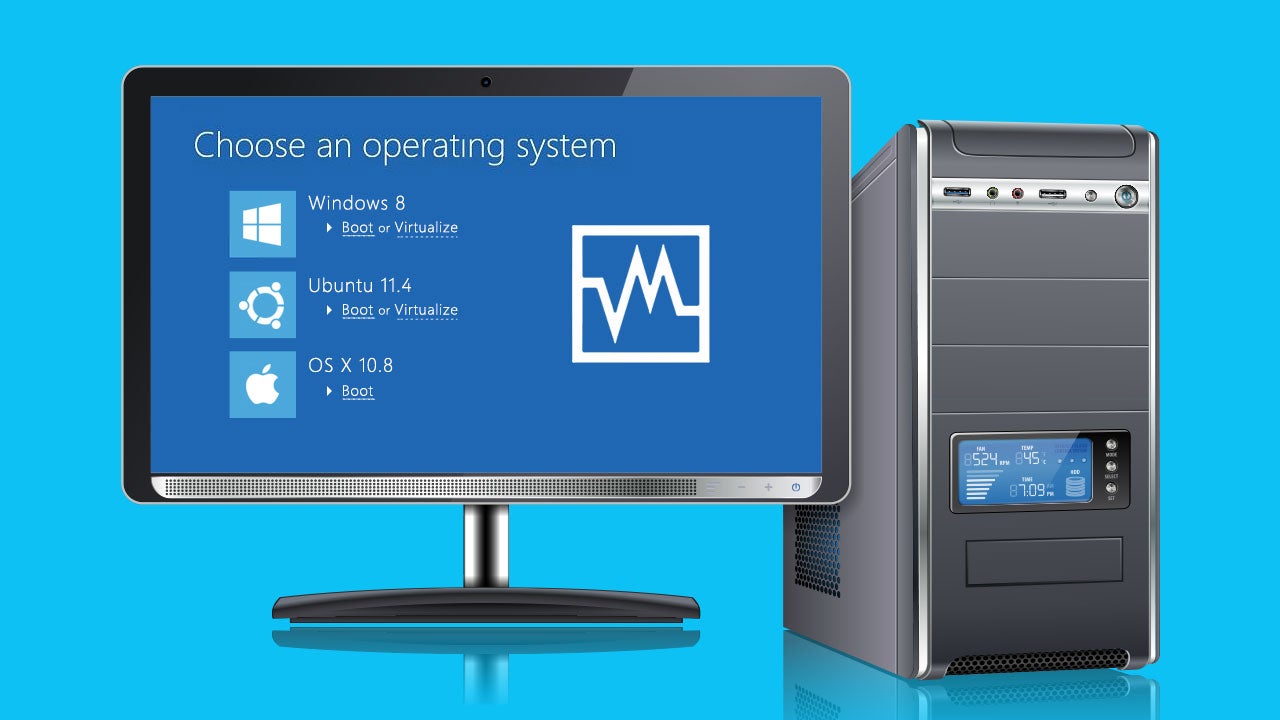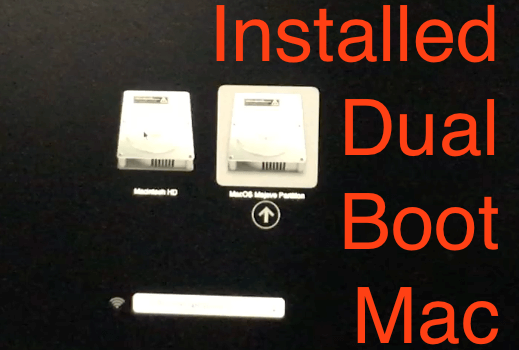- Access to macOS. After formatting the drive, the next step is to create a macOS flash drive installer.
- When your Mac powers up, it normally uses the system on its internal hard drive unless you change this behavior by choosing System Preferences@@→Startup Disk. You can also change what your Mac does by holding down the following keys or key combinations during startup. Print these boot option keys, because they're particularly helpful to have.
Please Follow it Step-by-step to avoid errors. This installation is done on hdd not ssd so if you are using ssd, when formating the ssd in macos utility sele. 2 days ago Dual boot Mac. Thread starter ltlredwagon1; Start date Yesterday at 6:53 PM; Sort (Likes) Forums. Mac Basics, Help and Buying Advice. Ltlredwagon1 macrumors newbie. Original poster. Sep 30, 2020 3 0. Yesterday at 6:53 PM #1 Currently have 2013 MacBook Pro with Sierra.
In the past, we have heard a lot about the new devices (usually tablets) with dual-boot feature built into the operating system. Some people may already know what dual booting is, but most are still unknown. Most users will probably scratch their heads and wonder: What is dual boot? And what are its advantages and disadvantages? Network administrators will help readers to answer this question through the following article.

In the past, we have heard a lot about the new devices (usually tablets) with dual-boot feature built into the operating system.
Some people may already know what dual booting is, but most are still unknown. Most users will probably scratch their heads and wonder: What is dual boot? And what are its advantages and disadvantages? Network administrators will help readers to answer this question through the following article.
What is dual boot?
Let's start with the basics. What is 'startup' when it comes to smartphones, tablets and even computers? It is basically turning on the device. More specifically, 'start up' means loading a set of instructions from memory after the machine is turned on or reset, eventually allowing the system to load the operating system and the necessary working environment. History forms the term and the process is quite interesting.
'Boot loader' is the main operating system loader (Android, Windows Phone, iOS, etc.) after completing the power-on Self Test (POST). Typically, the boot loader allows you to select the 'mode' you want to start, such as normal mode or recovery mode. The term 'Booting' stands for 'bootstrapping'.
Finally, the boot allows to go from the power off state to the operating system loading state. Dual booting allows switching from power off to menu where you can select the operating system you want to load. This menu can have one, two or even more options and each option will load the environment, driver and system needed for the selected option.
Advantages of dual boot
Today, smartphones and tablets are really great. They have CPU, GPU, RAM, storage, high-speed modems, wireless connectivity, high-resolution screens and power supplies, all integrated into a single device - and fit within Pretty small bag!
There are even many operating systems to choose from. If desktops and laptops can run operating systems such as Unix, Linux, Windows or Mac on a hardware, smartphone and tablet can only run a single operating system. If you want to switch to another operating system, you will usually have to change the hardware. Fix it up for mac.
In theory, dual-boot eliminates hardware redundancy, requires developers or users to reduce the number of devices they own and maintain. That is equivalent to saving at least a few hundred dollars, and can be much more than that.

However, there are some applications that are only suitable for running on a certain operating system. Sometimes, applications are not even available for one of the popular operating systems. To solve this problem, you can dual-boot from one operating system to another, and run the application in the most suitable environment without the need to purchase additional hardware or equipment.
Disadvantages of dual boot
There are several reasons why you do not want to dual boot on the device. In fact, dual boot brings some risks. The first is space. Running another operating system means that the operating system (and all its drivers, as well as its files) must be installed on the device. This really reduces the amount of storage available in the system.
Applications are often not cross-compatible between the two operating systems, so you may have to install separate versions for each operating system. This not only will need to buy two versions of each application, but also needs storage for each version. You will also have to spend time and bandwidth to update them. Developers will also have to spend time fixing and updating two separate base code sets for their applications, which often significantly slows the release cycle.
Typically, storage systems are incompatible between two operating systems or are not mapped to the same location. This means that downloading, creating, or editing files in this operating system will not be available in other operating systems without manually switching between the two operating systems, the work that people usually do by sending Copy the file via email. Moreover, the file formats used by an application version may not be compatible with other versions.
The last 'downside' we want to mention is time. It takes time to turn off an operating system and restart another operating system. Sometimes it only takes a minute or longer, but it is also a significant waiting period. Some dual-boot systems can run both operating systems simultaneously, allowing faster data exchange between them, but these configurations are not common and often occur when sharing resources. Which operating system will use and control LTE modems? Movie making softwares for mac. GPS? Sound? etc.
Finally, dual booting sounds great, but in fact, it can be more expensive and has more disadvantages than advantages . That is not to mention the fact that both Microsoft and Google are trying to prevent Anyone who is selling a device that can dual-boot into their operating systems.
See more:
- How to create dual boot Linux and Windows 10 on Linux
- How to create a new User on Windows 10 using Computer Management and Control Panel
- Instructions for creating dual boot Windows 8 and Linux Mint systems

Dual Boot For Mac Os
Boot Camp Control Panel User Guide
Dual Boot For Macbook
You can set the default operating system to either macOS or Windows. The default operating system is the one you want to use when you turn on or restart your Mac.
Set the default operating system
In Windows on your Mac, click in the right side of the taskbar, click the Boot Camp icon , then choose Boot Camp Control Panel.
Choose a kitchen template that is most similar to your project and customize it. Professional Kitchen Planning TemplatesSmartDraw includes quick-start kitchen plans to help you get started no matter how big your project. Thousands of Kitchen and Floor Planning SymbolsYou can drag-and-drop kitchen appliances, fixtures, faucets, cabinets and more.

If a User Account Control dialog appears, click Yes.
Select the startup disk that has the default operating system you want to use.
If you want to start up using the default operating system now, click Restart. Otherwise, click OK.
You can't change your startup volume to an external FireWire or USB drive while you're using Windows.
To learn how to change the default operating system using macOS, see Get started with Boot Camp.
Restart in macOS

In the past, we have heard a lot about the new devices (usually tablets) with dual-boot feature built into the operating system.
Some people may already know what dual booting is, but most are still unknown. Most users will probably scratch their heads and wonder: What is dual boot? And what are its advantages and disadvantages? Network administrators will help readers to answer this question through the following article.
What is dual boot?
Let's start with the basics. What is 'startup' when it comes to smartphones, tablets and even computers? It is basically turning on the device. More specifically, 'start up' means loading a set of instructions from memory after the machine is turned on or reset, eventually allowing the system to load the operating system and the necessary working environment. History forms the term and the process is quite interesting.
'Boot loader' is the main operating system loader (Android, Windows Phone, iOS, etc.) after completing the power-on Self Test (POST). Typically, the boot loader allows you to select the 'mode' you want to start, such as normal mode or recovery mode. The term 'Booting' stands for 'bootstrapping'.
Finally, the boot allows to go from the power off state to the operating system loading state. Dual booting allows switching from power off to menu where you can select the operating system you want to load. This menu can have one, two or even more options and each option will load the environment, driver and system needed for the selected option.
Advantages of dual boot
Today, smartphones and tablets are really great. They have CPU, GPU, RAM, storage, high-speed modems, wireless connectivity, high-resolution screens and power supplies, all integrated into a single device - and fit within Pretty small bag!
There are even many operating systems to choose from. If desktops and laptops can run operating systems such as Unix, Linux, Windows or Mac on a hardware, smartphone and tablet can only run a single operating system. If you want to switch to another operating system, you will usually have to change the hardware. Fix it up for mac.
In theory, dual-boot eliminates hardware redundancy, requires developers or users to reduce the number of devices they own and maintain. That is equivalent to saving at least a few hundred dollars, and can be much more than that.
However, there are some applications that are only suitable for running on a certain operating system. Sometimes, applications are not even available for one of the popular operating systems. To solve this problem, you can dual-boot from one operating system to another, and run the application in the most suitable environment without the need to purchase additional hardware or equipment.
Disadvantages of dual boot
There are several reasons why you do not want to dual boot on the device. In fact, dual boot brings some risks. The first is space. Running another operating system means that the operating system (and all its drivers, as well as its files) must be installed on the device. This really reduces the amount of storage available in the system.
Applications are often not cross-compatible between the two operating systems, so you may have to install separate versions for each operating system. This not only will need to buy two versions of each application, but also needs storage for each version. You will also have to spend time and bandwidth to update them. Developers will also have to spend time fixing and updating two separate base code sets for their applications, which often significantly slows the release cycle.
Typically, storage systems are incompatible between two operating systems or are not mapped to the same location. This means that downloading, creating, or editing files in this operating system will not be available in other operating systems without manually switching between the two operating systems, the work that people usually do by sending Copy the file via email. Moreover, the file formats used by an application version may not be compatible with other versions.
The last 'downside' we want to mention is time. It takes time to turn off an operating system and restart another operating system. Sometimes it only takes a minute or longer, but it is also a significant waiting period. Some dual-boot systems can run both operating systems simultaneously, allowing faster data exchange between them, but these configurations are not common and often occur when sharing resources. Which operating system will use and control LTE modems? Movie making softwares for mac. GPS? Sound? etc.
Finally, dual booting sounds great, but in fact, it can be more expensive and has more disadvantages than advantages . That is not to mention the fact that both Microsoft and Google are trying to prevent Anyone who is selling a device that can dual-boot into their operating systems.
See more:
- How to create dual boot Linux and Windows 10 on Linux
- How to create a new User on Windows 10 using Computer Management and Control Panel
- Instructions for creating dual boot Windows 8 and Linux Mint systems
Dual Boot For Mac Os
Boot Camp Control Panel User Guide
Dual Boot For Macbook
You can set the default operating system to either macOS or Windows. The default operating system is the one you want to use when you turn on or restart your Mac.
Set the default operating system
In Windows on your Mac, click in the right side of the taskbar, click the Boot Camp icon , then choose Boot Camp Control Panel.
Choose a kitchen template that is most similar to your project and customize it. Professional Kitchen Planning TemplatesSmartDraw includes quick-start kitchen plans to help you get started no matter how big your project. Thousands of Kitchen and Floor Planning SymbolsYou can drag-and-drop kitchen appliances, fixtures, faucets, cabinets and more. .
If a User Account Control dialog appears, click Yes.
Select the startup disk that has the default operating system you want to use.
If you want to start up using the default operating system now, click Restart. Otherwise, click OK.
You can't change your startup volume to an external FireWire or USB drive while you're using Windows.
To learn how to change the default operating system using macOS, see Get started with Boot Camp.
Restart in macOS
In Windows on your Mac, do one of the following:
Restart using Startup Manager: Restart your Mac, then immediately press and hold the Option key. When the Startup Manager window appears, release the Option key, select your macOS startup disk, then press Return.
If you're using a portable Mac with an external keyboard, make sure you press and hold the Option key on the built-in keyboard.
Restart using Boot Camp Control Panel: Click in the right side of the taskbar, click the Boot Camp icon , then choose Restart in macOS.
This also sets the default operating system to macOS.
For more information about restarting in macOS, see the Apple Support article Switch between Windows and macOS.
